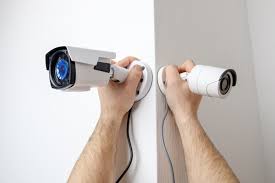Installing a CCTV (Closed-Circuit Television) system is one of the most reliable ways to improve the security of your home or business. With the rise in property-related crimes and growing concerns about safety, more people are turning to CCTV as a cost-effective and practical solution.
This guide explains everything you need to know about CCTV installation—from planning and equipment to setup and maintenance. Whether you’re considering professional installation or simply want to understand the process, this article breaks it down in clear and simple language.
Why You Should Install CCTV
CCTV cameras provide both prevention and protection. Just the sight of a camera can stop criminals from targeting your property. If an incident does occur, CCTV footage provides strong evidence that can assist police investigations or insurance claims.
Other benefits include:
- Monitoring activity in real time
- Enhancing the safety of employees, customers, or family members
- Reducing the risk of theft or vandalism
- Keeping an eye on deliveries or service staff
- Improving overall peace of mind
Step-by-Step CCTV Installation Process
1. Site Inspection and Consultation
The process usually begins with a professional visiting your property to assess:
- Entry and exit points
- Vulnerable or hidden areas
- Lighting conditions
- Indoor vs. outdoor coverage
- Number of cameras needed
Based on this assessment, they recommend the best type of CCTV system for your property size and security needs.
2. Selecting the Right Equipment
There are different types of CCTV cameras and systems. Choosing the right one depends on your goals and budget.
Common camera options include:
- Dome Cameras: Ideal for indoor use with wide-angle coverage
- Bullet Cameras: Suitable for outdoor surveillance
- PTZ Cameras: Offer pan, tilt, and zoom capabilities for large areas
- Wireless Cameras: Easier to install, especially in finished buildings
- Night Vision Cameras: Essential for low-light or nighttime security
In addition to cameras, you’ll also need:
- DVR or NVR: For recording footage
- Monitor: For live viewing
- Cables and Connectors: For power and video transmission (unless wireless)
- Hard Drive: For storing video (usually 1TB or more)
3. Camera Placement
Strategic camera placement is critical for full property coverage. Experts consider:
- Entryways (doors, gates, garages)
- Driveways and walkways
- Blind spots not visible from inside
- Areas where valuables are stored
- Open spaces like backyards or parking lots
The goal is to minimize blind spots and ensure maximum visibility, both day and night.
4. Cabling and Power Supply
If you’re using a wired CCTV system, installers will run power and data cables through the walls or ceilings. To ensure safety and appearance, cables are usually hidden inside conduits or along edges.
Wireless systems still need a power supply, unless the cameras are battery-operated. Even then, batteries need regular charging or replacement.
5. Installing Cameras and Devices
Once planning and wiring are complete, the actual installation begins:
- Cameras are securely mounted using brackets
- DVR/NVR units are placed in a safe but accessible location
- Monitors are connected for live viewing
- Power supply is tested
Professional installers make sure the cameras are firmly fixed and angled properly to cover the target areas without obstruction or glare.
6. Configuration and Setup
Now the system is configured for optimal use:
- Motion detection zones are set
- Recording schedules are defined
- Video quality and frame rate are adjusted
- Storage settings are confirmed
- Mobile apps or software are installed for remote access
You’ll also receive a demonstration of how to use the system: playing back footage, switching camera views, and using mobile alerts.
What You Need to Install CCTV
Before installation begins, make sure you have or can provide:
- A reliable power source
- A stable internet connection (if remote viewing is required)
- A suitable mounting surface (walls, ceilings, poles)
- Permission (if required) – e.g., in rented properties or shared spaces
- Awareness of local privacy laws – don’t install cameras where people expect privacy, like bathrooms or neighbors’ property
DIY vs. Professional CCTV Installation
Many people ask: should I install it myself or hire a professional?
DIY Pros:
- Lower upfront cost
- Flexible scheduling
- Personal control over installation
DIY Cons:
- Risk of incorrect placement
- Limited technical knowledge
- No warranty or support
- Potential legal issues from poor setup
Professional Installation Pros:
- Expert site analysis
- Neat and safe cable management
- High-quality equipment
- Reliable after-sales support
- Legal compliance
- Peace of mind
Unless you’re experienced with security systems, professional installation is usually the better choice.
Maintenance After Installation
Once your CCTV system is running, regular maintenance will keep it effective:
- Clean camera lenses to avoid blurred images
- Check cables and connections for wear or damage
- Ensure storage (hard drive or cloud) is not full
- Update software and security settings
- Test playback features regularly
Some companies offer maintenance contracts for yearly or quarterly checkups.
Legal Considerations
In most places, it’s legal to install CCTV on your own property. However, you must follow rules like:
- Not recording areas outside your property (e.g., a neighbor’s window)
- Informing visitors or employees that CCTV is in use
- Not using CCTV audio unless permitted by law
Professional installers are usually aware of local regulations and can help you stay compliant.
Common Questions About CCTV Installation
Can CCTV work without the internet?
Yes. It can record to a hard drive without needing the internet. But internet is required for remote access or cloud storage.
Do CCTV cameras work at night?
Yes, if you choose cameras with infrared night vision or low-light sensors.
Can I view footage on my phone?
Yes. Most modern systems come with apps for iOS and Android that let you monitor live feeds or review recordings.
How much does CCTV installation cost?
It depends on the number of cameras, type of system, and installation complexity. On average, prices range from \$500 to \$2,500+ for complete systems including installation.
Final Thoughts
CCTV installation is a smart investment that offers protection, peace of mind, and confidence. A well-installed system covers all key areas, works 24/7, and lets you monitor your property even when you’re away.
While DIY options exist, a professional installer will save you time, ensure quality, and help you avoid common mistakes.
If you’re looking for expert CCTV installation in Adelaide, consider this trusted provider: Aussie Tech Solutions – CCTV & Camera Security Services in Adelaide










